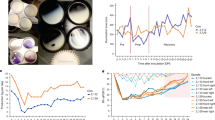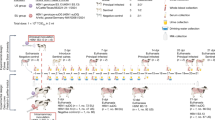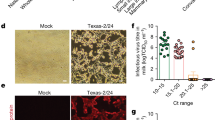Abstract
Since early 2022, highly pathogenic avian influenza (HPAI) H5N1 virus infections have been reported in wild aquatic birds and poultry throughout the USA with spillover into several mammalian species1,2,3,4,5,6. In March 2024, HPAIV H5N1 clade 2.3.4.4b was first detected in dairy cows in Texas, USA, and continues to circulate on dairy farms in many states7,8. Milk production and quality are diminished in infected dairy cows, with high virus titres in milk raising concerns of exposure to mammals including humans through consumption9,10,11,12. Here we investigated routes of infection with bovine HPAIV H5N1 clade 2.3.4.4b in cynomolgus macaques, a surrogate model for human infection13. We show that intranasal or intratracheal inoculation of macaques could cause systemic infection resulting in mild and severe respiratory disease, respectively. By contrast, infection by the orogastric route resulted in limited infection and seroconversion of macaques that remained subclinical.
This is a preview of subscription content, access via your institution
Access options
Access Nature and 54 other Nature Portfolio journals
Get Nature+, our best-value online-access subscription
$32.99 / 30 days
cancel any time
Subscribe to this journal
Receive 51 print issues and online access
$199.00 per year
only $3.90 per issue
Buy this article
- Purchase on SpringerLink
- Instant access to full article PDF
Prices may be subject to local taxes which are calculated during checkout


Similar content being viewed by others
Data availability
Raw data are available at Figshare (https://doi.org/10.6084/m9.figshare.27763944)37. Viral sequences were deposited into GenBank under submission number SUB14944743 (accession numbers PQ790100–PQ790155).
References
Kandeil, A. et al. Rapid evolution of A(H5N1) influenza viruses after intercontinental spread to North America. Nat. Commun. 14, 3082 (2023).
Youk, S. et al. H5N1 highly pathogenic avian influenza clade 2.3.4.4b in wild and domestic birds: introductions into the United States and reassortments, December 2021-April 2022. Virology 587, 109860 (2023).
Alkie, T. N. et al. Characterization of neurotropic HPAI H5N1 viruses with novel genome constellations and mammalian adaptive mutations in free-living mesocarnivores in Canada. Emerg. Microbes Infect. 12, 2186608 (2023).
Cronk, B. D. et al. Infection and tissue distribution of highly pathogenic avian influenza A type H5N1 (clade 2.3.4.4b) in red fox kits (Vulpes vulpes). Emerg. Microbes Infect. 12, 2249554 (2023).
Sillman, S. J., Drozd, M., Loy, D. & Harris, S. P. Naturally occurring highly pathogenic avian influenza virus H5N1 clade 2.3.4.4b infection in three domestic cats in North America during 2023. J. Comp. Pathol. 205, 17–23 (2023).
Puryear, W. et al. Highly pathogenic avian influenza A(H5N1) virus outbreak in New England seals, United States. Emerg. Infect. Dis. 29, 786–791 (2023).
CDC. H5 Bird flu: current situation; https://www.cdc.gov/bird-flu/situation-summary/index.html (2024).
USDA-APHIS. HPAI confirmed cases in livestock;. https://www.aphis.usda.gov/livestock-poultry-disease/avian/avian-influenza/hpai-detections/hpai-confirmed-cases-livestock (2024).
Le Sage, V., Campbell, A. J., Reed, D. S., Duprex, W. P. & Lakdawala, S. S. Persistence of influenza H5N1 and H1N1 viruses in unpasteurized milk on milking unit surfaces. Emerg. Infect. Dis. 30, 1721–1723 (2024).
FDA. Updates on highly pathogenic avian influenza (HPAI); https://www.fda.gov/food/alerts-advisories-safety-information/updates-highly-pathogenic-avian-influenza-hpai (2024).
Halwe, N. J. et al. H5N1 clade 2.3.4.4b dynamics in experimentally infected calves and cows. Nature 637, 903–912 (2025).
Guan, L. et al. Cow’s milk containing avian influenza A(H5N1) virus—heat inactivation and infectivity in mice. New Engl. J. Med. 391, 87–90 (2024).
Gardner, M. B. & Luciw, P. A. Macaque models of human infectious disease. Ilar. J. 49, 220–255 (2008).
Kaiser, F. et al. Inactivation of avian influenza A(H5N1) virus in raw milk at 63 degrees C and 72 degrees C. N. Engl. J. Med. 391, 90–92 (2024).
Schafers, J. et al. Pasteurisation temperatures effectively inactivate influenza A viruses in milk. Nat. Commun. 16, 1173 (2025).
Lando, A. M., Bazaco, M. C., Parker, C. C. & Ferguson, M. Characteristics of U.S. consumers reporting past year intake of raw (unpasteurized) milk: results from the 2016 Food Safety Survey and 2019 Food Safety and Nutrition Survey. J. Food Prot. 85, 1036–1043 (2022).
Rosenke, K. et al. Combined molnupiravir-nirmatrelvir treatment improves the inhibitory effect on SARS-CoV-2 in macaques. JCI Insight 8, e166485 (2023).
Caserta, L. C. et al. Spillover of highly pathogenic avian influenza H5N1 virus to dairy cattle. Nature 634, 669–676 (2024).
Munster, V. J. et al. Respiratory disease in rhesus macaques inoculated with SARS-CoV-2. Nature 585, 268–272 (2020).
Wonderlich, E. R. et al. Widespread virus replication in alveoli drives acute respiratory distress syndrome in aerosolized H5N1 influenza infection of macaques. J. Immunol. 198, 1616–1626 (2017).
Port, J. R. et al. Increased small particle aerosol transmission of B.1.1.7 compared with SARS-CoV-2 lineage A in vivo. Nat. Microbiol. 7, 213–223 (2022).
Guo, X. et al. Molecular markers and mechanisms of influenza a virus cross-species transmission and new host adaptation. Viruses 16, 883 (2024).
Eisfeld, A. J. et al. Pathogenicity and transmissibility of bovine H5N1 influenza virus. Nature 633, 426–432 (2024).
Tipih, T. et al. Recent bovine HPAI H5N1 isolate is highly virulent for mice, rapidly causing acute pulmonary and neurologic disease. Preprint at bioRxiv https://doi.org/10.1101/2024.08.19.608652 (2024).
CDC. CDC reports A(H5N1) ferret study results; https://www.cdc.gov/bird-flu/spotlights/ferret-study-results.html (2024).
Pulit-Penaloza, J. A. et al. Highly pathogenic avian influenza A(H5N1) virus of clade 2.3.4.4b isolated from a human case in Chile causes fatal disease and transmits between co-housed ferrets. Emerg. Microbes Infect. 13, 2332667 (2024).
Belser, J. A., Sun, X., Pulit-Penaloza, J. A. & Maines, T. R. Fatal infection in ferrets after ocular inoculation with highly pathogenic avian influenza A(H5N1) virus. Emerg. Infect. Dis. 30, 1484–1487 (2024).
Watanabe, T. et al. Experimental infection of cynomolgus macaques with highly pathogenic H5N1 influenza virus through the aerosol route. Sci. Rep. 8, 4801 (2018).
Kanekiyo, M. et al. Refined semi-lethal aerosol H5N1 influenza model in cynomolgus macaques for evaluation of medical countermeasures. iScience 26, 107830 (2023).
Rimmelzwaan, G. F. et al. Pathogenesis of Influenza A (H5N1) virus infection in a primate model. J. Virology 75, 6687–6691 (2001).
Baskin, C. R. et al. Early and sustained innate immune response defines pathology and death in nonhuman primates infected by highly pathogenic influenza virus. Proc. Natl Acad. Sci. USA 106, 3455–3460 (2009).
Fujiyuki, T. et al. Experimental infection of macaques with a wild water bird-derived highly pathogenic avian influenza virus (H5N1). PLoS ONE 8, e83551 (2013).
Soloff, A. C. et al. Massive mobilization of dendritic cells during influenza A virus subtype H5N1 infection of nonhuman primates. J. Infect. Dis. 209, 2012–2016 (2014).
Muramoto, Y. et al. Disease severity is associated with differential gene expression at the early and late phases of infection in nonhuman primates infected with different H5N1 highly pathogenic avian influenza viruses. J. Virology 88, 8981–8997 (2014).
Kuiken, T., Rimmelzwaan, G. F., Van Amerongen, G. & Osterhaus, A. D. M. E. Pathology of human influenza A (H5N1) virus infection in cynomolgus macaques (Macaca fascicularis). Vet. Pathol. 40, 304–310 (2003).
Mooij, P. et al. Aerosolized exposure to H5N1 influenza virus causes less severe disease than infection via combined intrabronchial, oral, and nasal inoculation in cynomolgus macaques. Viruses 13, 345 (2021).
Rosenke, K. et al. Orogastric exposure of macaques to bovine H5N1 causes subclinical infection. Figshare https://doi.org/10.6084/m9.figshare.27763944 (2024).
Acknowledgements
The work was funded by the Intramural Research Program of NIAID, NIH. We thank R. Webby from St. Jude Children Hospital and A. Bowman from Ohio State University for providing the bovine HPAIV H5N1 clade 2.3.4.4b isolate. We thank K. O’Donnell and A. Marzi (both NIAID, NIH) for serological reagents. We thank the Visual and Medical Arts Unit, NIAID, NIH (A. Mora, R. Kissinger, A. Stewart and S. Tudor) for graphical assistance. We thank the staff of the Research Technology Branch, NIAID, NIH for assistance with sequencing and sequence analysis. We also thank the staff of the Rocky Mountain Veterinary Branch, NIAID, NIH for animal care and histopathology service. Finally, we thank the Office of the Chief, LV, NIAID, NIH for general biocontainment services.
Author information
Authors and Affiliations
Contributions
K.R., E.d.W., V.J.M. and H.F. designed the study. V.J.M., E.W. and K.C.Y. acquired virus isolates, grew virus stock and confirmed virus sequences. K.R., A.G., F.K., E.A., R.M., T.B., M.F., T.T., K.G., A.W., B.N.W., S.G., S.S.L., T.L., A.O., M.C.L., K.C.Y., D.R., B.J.S., K.K., C.M., C.S., G.S., P.H., N.v.D., E.d.W., V.J.M. and H.F. performed experiments and data analysis. K.R., E.d.W., V.J.M. and H.F. wrote the manuscript. E.d.W., V.J.M. and H.F. obtained funding. All authors reviewed and contributed to preparation of the final manuscript.
Corresponding authors
Ethics declarations
Competing interests
The authors declare no competing interests.
Peer review
Peer review information
Nature thanks Lineke Begeman, Malik Peiris, Douglas Reed and Guelsah Gabriel for their contribution to the peer review of this work. Peer reviewer reports are available.
Additional information
Publisher’s note Springer Nature remains neutral with regard to jurisdictional claims in published maps and institutional affiliations.
Extended data figures and tables
Extended Data Fig. 1 Weights and Temperatures in Cynomolgus macaques following inoculation with HPAIV H5N1.
Weights (A) and Temperatures (B) were collected at each clinical exam and at the time of euthanasia. Data represent 3 animals per inoculation route with the line at the mean with standard deviation displayed.
Extended Data Fig. 2 Blood Chemistries.
Serum was collected at each clinical exam and at the time of euthanasia to assess organ function over the course of the study. Data represent 3 animals per inoculation route with the line at the mean with standard deviation displayed.
Extended Data Fig. 3 Hematology.
Whole blood was collected at each clinical exam and at the time of euthanasia to assess the effects of inoculation over the course of the study. Data represent 3 animals per inoculation route with the line at the mean with standard deviation displayed.
Extended Data Fig. 4 Tissue titers.
Infectious virus was measured in tissues at D4/D5. Data points represent individual animals per inoculation route (n = 3) with the bar at the mean with standard deviation displayed.
Extended Data Fig. 5 Acute Disease.
Pulmonary lesions observed in two lobes of one orogastric (oral cavity and gavage) and one lobe in two intranasally inoculated animals. Mild signs of pneumonia was observed with limited macrophage and neutrophil infiltration. HE: Asterisk = edema, IHC: Arrows = macrophages, arrowhead = bronchiolar epithelium. 200X; bar = 50 µm.
Extended Data Fig. 6 Cytokine and Chemokine levels.
Serum was collected during the first 5 days of the study to compare cytokine and chemokine levels across the three inoculation groups. Data points represent individual animals per inoculation route (n = 6) with the bar at the mean with standard deviation displayed. P-values = * <0.05, ** <0.01, *** <0.001, **** <0.0001.
Supplementary information
Rights and permissions
About this article
Cite this article
Rosenke, K., Griffin, A., Kaiser, F. et al. Pathogenesis of bovine H5N1 clade 2.3.4.4b infection in macaques. Nature 640, 1017–1021 (2025). https://doi.org/10.1038/s41586-025-08609-8
Received:
Accepted:
Published:
Issue date:
DOI: https://doi.org/10.1038/s41586-025-08609-8



